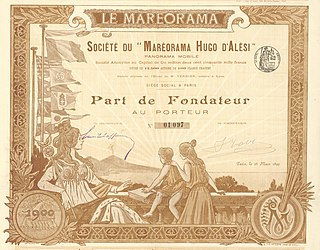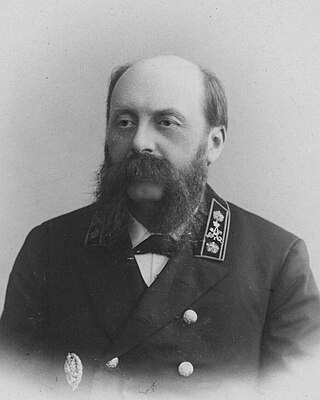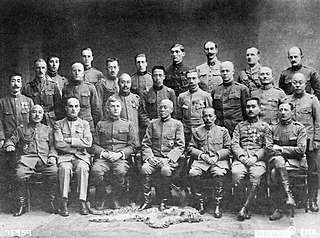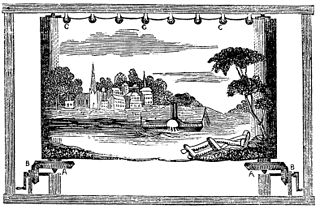
The Trans-Siberian Railway, historically known as the Great Siberian Route and often shortened to Transsib, is a large railway system that connects European Russia to the Russian Far East. Spanning a length of over 9,289 kilometers, it is the longest railway line in the world. It runs from the city of Moscow in the west to the city of Vladivostok in the east.

The Baikal–Amur Mainline is a 1,520 mm broad-gauge railway line in Russia. Traversing Eastern Siberia and the Russian Far East, the 4,324 km (2,687 mi)-long BAM runs about 610 to 770 km north of and parallel to the Trans-Siberian Railway.

Ulan-Ude is the capital city of Buryatia, Russia, located about 100 kilometers (62 mi) southeast of Lake Baikal on the Uda River at its confluence with the Selenga. According to the 2021 Census, 437,565 people lived in Ulan-Ude; up from 404,426 recorded in the 2010 Census, making the city the third-largest in the Russian Far East by population.

Panoramic paintings are massive artworks that reveal a wide, all-encompassing view of a particular subject, often a landscape, military battle, or historical event. They became especially popular in the 19th century in Europe and the United States, inciting opposition from some writers of Romantic poetry. A few have survived into the 21st century and are on public display. Typically shown in rotundas for viewing, panoramas were meant to be so lifelike they confused the spectator between what was real and what was image.

A panorama is any wide-angle view or representation of a physical space, whether in painting, drawing, photography, film, seismic images, or 3D modeling. The word was coined in the 18th century by the English painter Robert Barker to describe his panoramic paintings of Edinburgh and London. The motion-picture term panning is derived from panorama.

A moving walkway, also known as an autowalk, moving pavement, moving sidewalk, people-mover, travolator, or travelator, is a slow-moving conveyor mechanism that transports people across a horizontal or inclined plane over a short to medium distance. Moving walkways can be used by standing or walking on them. They are often installed in pairs, one for each direction.

The Exposition Universelle of 1900, better known in English as the 1900 Paris Exposition, was a world's fair held in Paris, France, from 14 April to 12 November 1900, to celebrate the achievements of the past century and to accelerate development into the next. It was the sixth of ten major expositions held in the city between 1855 and 1937. It was held at the esplanade of Les Invalides, the Champ de Mars, the Trocadéro and at the banks of the Seine between them, with an additional section in the Bois de Vincennes, and it was visited by more than fifty million people. Many international congresses and other events were held within the framework of the exposition, including the 1900 Summer Olympics.
A cyclorama is a panoramic image on the inside of a cylindrical platform, designed to give viewers standing in the middle of the cylinder a 360° view, and also a building designed to show a panoramic image. The intended effect is to make viewers, surrounded by the panoramic image, feel as if they were standing in the midst of the place depicted in the image.

The Eurasian Land Bridge, sometimes called the New Silk Road, is the rail transport route for moving freight and passengers overland between Pacific seaports in the Russian Far East and China and seaports in Europe. The route, a transcontinental railroad and rail land bridge, currently comprises the Trans-Siberian Railway, which runs through Russia and is sometimes called the Northern East-West Corridor, and the New Eurasian Land Bridge or Second Eurasian Continental Bridge, running through China and Kazakhstan. As of November 2007, about one percent of the $600 billion in goods shipped from Asia to Europe each year were delivered by inland transport routes.

The Science Museum of Virginia is a science museum located in Richmond, Virginia. Established in 1970, it is an agency of the Commonwealth of Virginia. It is housed in the former Broad Street Station, built in 1917.

The Mareorama was an entertainment attraction at the 1900 Paris Exposition. It was created by Hugo d'Alesi (fr), a painter of advertising posters, and was a combination of moving panoramic paintings and a large motion platform. It is regarded as one of the last major developments in the technology of panoramas, shortly before the medium became obsolete.

Cinéorama was an early film experiment and amusement ride presented for the first time at the 1900 Paris Exposition. It was invented by Raoul Grimoin-Sanson and it simulated a ride in a hot air balloon over Paris. It represented a union of the earlier technology of panoramic paintings and the recently invented technology of cinema. It worked by means of a circulatory screen that projects images helped by ten synchronized projectors.

Nikolai Apollonovich Belelubsky was a distinguished Russian academic specialising in railway and civil engineering. Throughout his life, he became a member of many learned societies and the author of many papers and lectures.

The Siberian intervention or Siberian expedition of 1918–1922 was the dispatch of troops of the Entente powers to the Russian Maritime Provinces as part of a larger effort by the western powers, Japan, and China to support White Russian forces and the Czechoslovak Legion against Soviet Russia and its allies during the Russian Civil War. The Imperial Japanese Army continued to occupy Siberia even after other Allied forces withdrew in 1920.

The moving panorama was an innovation on panoramic painting in the mid-nineteenth century. It was among the most popular forms of entertainment in the world, with hundreds of panoramas constantly on tour in the United Kingdom, the United States, and many European countries. Moving panoramas were often seen in melodramatic plays. It became a new visual element to theatre and helped incorporate a more realistic quality. Not only was it a special effect on stage, but it also served as an ancestor and platform to early cinema.
La prose du Transsibérien et de la Petite Jehanne de France is a collaborative artists' book by Blaise Cendrars and Sonia Delaunay-Terk. The book features a poem by Cendrars about a journey through Russia on the Trans-Siberian Express in 1905, during the first Russian Revolution, interlaced with an almost-abstract pochoir print by Delaunay-Terk. The work, published in 1913, is considered a milestone in the evolution of artist's books as well as modernist poetry and abstract art.

Yekaterinburg–Passazhirsky is the central passenger railway station in Yekaterinburg, a major transportation hub, located on the Trans-Siberian main line and Sverdlovsk Railway. The station complex consisting of 4 buildings, provides 60 per diem departure passenger and commuter trains more than 180.

Sylvain Tesson is a French writer and traveller born in Paris. He has engaged in a number of unusual travels and expeditions which are the basis for his books. Among his most successful works are The Consolations of the Forest (2011), about a project to live alone in a Siberian cabin for six months and The Art of Patience (2019), about the quest for snow leopards in Tibet. For the latter book, he received the Prix Renaudot.
Mishaps of the New York–Paris Race was a 1908 French silent comedy film directed by Georges Méliès. Inspired by the real 1908 New York to Paris Race, which concluded shortly before its release, the film followed a group of racers through a hectic series of unlikely obstacles and adventures across North America, Russia, and Western Europe in a highly unreliable race car. Film scholars have noted parallels to earlier Méliès films, including The Impossible Voyage and An Adventurous Automobile Trip, and have commented on elements of racism in the scenario, but the film itself is currently presumed lost.

Sophia Ivanovna Kramskaya was a Russian painter of the Realist movement.

















